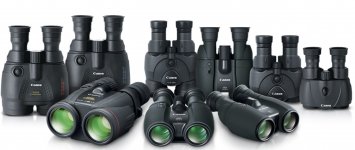-
Welcome to BirdForum, the internet's largest birding community with thousands of members from all over the world. The forums are dedicated to wild birds, birding, binoculars and equipment and all that goes with it.
Please register for an account to take part in the discussions in the forum, post your pictures in the gallery and more.
You are using an out of date browser. It may not display this or other websites correctly.
You should upgrade or use an alternative browser.
You should upgrade or use an alternative browser.
Premium (Alpha) vs Image stabilized (1 Viewer)
- Thread starter Paultricounty
- Start date
More options
Who Replied?A lot of times I will walk with them for moderate distances. I really don't hike for miles anymore, like I did was I was in my twenties. There is really no advantage to hiking for miles in Yellowstone because all the cool stuff to see has boardwalks going to it. They have found all the most interesting things to see and there are usually boardwalks going to them. If you hike, you will see nobody, and you are in wilderness basically if you hike 1/2 mile off the road. You see very few animals hiking, either. Most of the bears and wolves you see will be from the road, looking into the expansive valleys. For birding, you don't need to hike very far to see interesting birds.Dennis, am I right in understanding you don't walk with them because they are too heavy? You use them as a car binocular?
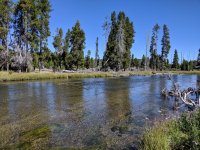
Last edited:
You don't have this one because I took it.I think I have that same picture 😟
Gas, usually.He is likely on two wheels. Either gas or electric?
Paul,
I join in thanking you for a good, comprehensive and fair evaluation of the Canons. I specifically commend you for the way you are able to come to a conclusion different from what you expected in face of new experiences rather than trying to find ways to hold on to opinions that were based on your previous experience.
I'll write more later when I have better time, but a couple of quick comments to the thread.
Firstly, the optical axis separation between the two objectives in the 10x42 L is 70 mm, which means that it gives a stereo base equal to bare eyes for people with 70 mm IPD, and slightly reduced stereopsis for those with larger IPDs and slightly enhanced stereopsis for people with smaller IPD's. So what Dennis said earlier about porro-like stereopsis in these is simply not true.
Secondly, because of the way the IPD adjustment works, it is remarkably easy to make your own IPD marking on the binocular body/rotating prism housing to accurately get back to your own setting if somebody else has used them. I find this most valuable and time-saving, as at least for me, having IPD set exactly right improves the image.
Thirdly, at least my sample has sharpness in the centre of the field fully on par with the best 10x binoculars I have measured. The list I have compared mine to includes Swaro EL 10x42 and 10x50, SLC 10x56, Noctivid, Zeiss SF and SFL, Swaro NL Pure and many others. All these I have tested tripod-mounted with an USAF resolution target, both naked-eye and with a 3x12 booster. That said, nearly every binocular I have tested shows sample variation between the left and right tubes. This is usually very easily seen in the boosted image, and when the difference is pronounced, it is also visible with naked eye as more softness and slightly lower contrast in the weaker tube's image. For there to be a one-step difference in naked eye line-pair resolution, however, the worse tube would have to be pretty terrible. My sample of the Canon IS L has a really good left tube and an okay but not great right tube with coma coming from slight misalignment of some lens element relative to the optical axis. It is not bad enough to really influence the image if it is in focus, but easy to see in out-of-focus points of light in normal viewing. I trust that you are correct about observing that your Canon is not quite as sharp as the alphas you are comparing it to, but would suggest that a better sample would be.
The optical construction of the Canon 10x42 seems to be unusually well corrected for spherical aberration. Among all the binoculars I have tested, it is the only one which gives anywhere close to identical diffraction ring patterns on either side of focus. This can be easily seen when viewing stars or glitter points during the day, and improves macro-contrast as well as the general perception of sharpness.
My last comment concerns holding the binocular for extended viewing. Here, I exploit the tripod attachment and use a short, about two foot long monopod so that I can keep my hands at about waist level, binoculars leaning lightly against my brow and stabiliser engaged. For Dennis viewing for wildlife in the National parks, this would be a great solution. I use it at migration watch, and can keep scanning the skies pretty much indefinitely like this. I'll try to post a few photos later this weekend. Because the Canon has the threaded hole, no binocular support is needed, which pretty much equalises the weight differential between the Canon and something like the NL Pure if it were mounted in a similar way.
Keep up the good work,
Kimmo
I join in thanking you for a good, comprehensive and fair evaluation of the Canons. I specifically commend you for the way you are able to come to a conclusion different from what you expected in face of new experiences rather than trying to find ways to hold on to opinions that were based on your previous experience.
I'll write more later when I have better time, but a couple of quick comments to the thread.
Firstly, the optical axis separation between the two objectives in the 10x42 L is 70 mm, which means that it gives a stereo base equal to bare eyes for people with 70 mm IPD, and slightly reduced stereopsis for those with larger IPDs and slightly enhanced stereopsis for people with smaller IPD's. So what Dennis said earlier about porro-like stereopsis in these is simply not true.
Secondly, because of the way the IPD adjustment works, it is remarkably easy to make your own IPD marking on the binocular body/rotating prism housing to accurately get back to your own setting if somebody else has used them. I find this most valuable and time-saving, as at least for me, having IPD set exactly right improves the image.
Thirdly, at least my sample has sharpness in the centre of the field fully on par with the best 10x binoculars I have measured. The list I have compared mine to includes Swaro EL 10x42 and 10x50, SLC 10x56, Noctivid, Zeiss SF and SFL, Swaro NL Pure and many others. All these I have tested tripod-mounted with an USAF resolution target, both naked-eye and with a 3x12 booster. That said, nearly every binocular I have tested shows sample variation between the left and right tubes. This is usually very easily seen in the boosted image, and when the difference is pronounced, it is also visible with naked eye as more softness and slightly lower contrast in the weaker tube's image. For there to be a one-step difference in naked eye line-pair resolution, however, the worse tube would have to be pretty terrible. My sample of the Canon IS L has a really good left tube and an okay but not great right tube with coma coming from slight misalignment of some lens element relative to the optical axis. It is not bad enough to really influence the image if it is in focus, but easy to see in out-of-focus points of light in normal viewing. I trust that you are correct about observing that your Canon is not quite as sharp as the alphas you are comparing it to, but would suggest that a better sample would be.
The optical construction of the Canon 10x42 seems to be unusually well corrected for spherical aberration. Among all the binoculars I have tested, it is the only one which gives anywhere close to identical diffraction ring patterns on either side of focus. This can be easily seen when viewing stars or glitter points during the day, and improves macro-contrast as well as the general perception of sharpness.
My last comment concerns holding the binocular for extended viewing. Here, I exploit the tripod attachment and use a short, about two foot long monopod so that I can keep my hands at about waist level, binoculars leaning lightly against my brow and stabiliser engaged. For Dennis viewing for wildlife in the National parks, this would be a great solution. I use it at migration watch, and can keep scanning the skies pretty much indefinitely like this. I'll try to post a few photos later this weekend. Because the Canon has the threaded hole, no binocular support is needed, which pretty much equalises the weight differential between the Canon and something like the NL Pure if it were mounted in a similar way.
Keep up the good work,
Kimmo
View attachment 1460265View attachment 1460265
Here is a good use case for the 18x50 IS.
A buzzard on a tree on the horizon.....a quick grab of the x18s and possible to watch it for 5 minutes, until it flies away.
Not the best phone pictures...... handheld.....and through a double glazed window. Point of note is the edge performance of the x18, not bad in my book.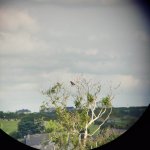
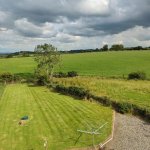
Here is a good use case for the 18x50 IS.
A buzzard on a tree on the horizon.....a quick grab of the x18s and possible to watch it for 5 minutes, until it flies away.
Not the best phone pictures...... handheld.....and through a double glazed window. Point of note is the edge performance of the x18, not bad in my book.


Last edited:
Paultricounty
Well-known member

Thx Kimmo,Paul,
I join in thanking you for a good, comprehensive and fair evaluation of the Canons. I specifically commend you for the way you are able to come to a conclusion different from what you expected in face of new experiences rather than trying to find ways to hold on to opinions that were based on your previous experience.
I'll write more later when I have better time, but a couple of quick comments to the thread.
Firstly, the optical axis separation between the two objectives in the 10x42 L is 70 mm, which means that it gives a stereo base equal to bare eyes for people with 70 mm IPD, and slightly reduced stereopsis for those with larger IPDs and slightly enhanced stereopsis for people with smaller IPD's. So what Dennis said earlier about porro-like stereopsis in these is simply not true.
Secondly, because of the way the IPD adjustment works, it is remarkably easy to make your own IPD marking on the binocular body/rotating prism housing to accurately get back to your own setting if somebody else has used them. I find this most valuable and time-saving, as at least for me, having IPD set exactly right improves the image.
Thirdly, at least my sample has sharpness in the centre of the field fully on par with the best 10x binoculars I have measured. The list I have compared mine to includes Swaro EL 10x42 and 10x50, SLC 10x56, Noctivid, Zeiss SF and SFL, Swaro NL Pure and many others. All these I have tested tripod-mounted with an USAF resolution target, both naked-eye and with a 3x12 booster. That said, nearly every binocular I have tested shows sample variation between the left and right tubes. This is usually very easily seen in the boosted image, and when the difference is pronounced, it is also visible with naked eye as more softness and slightly lower contrast in the weaker tube's image. For there to be a one-step difference in naked eye line-pair resolution, however, the worse tube would have to be pretty terrible. My sample of the Canon IS L has a really good left tube and an okay but not great right tube with coma coming from slight misalignment of some lens element relative to the optical axis. It is not bad enough to really influence the image if it is in focus, but easy to see in out-of-focus points of light in normal viewing. I trust that you are correct about observing that your Canon is not quite as sharp as the alphas you are comparing it to, but would suggest that a better sample would be.
The optical construction of the Canon 10x42 seems to be unusually well corrected for spherical aberration. Among all the binoculars I have tested, it is the only one which gives anywhere close to identical diffraction ring patterns on either side of focus. This can be easily seen when viewing stars or glitter points during the day, and improves macro-contrast as well as the general perception of sharpness.
My last comment concerns holding the binocular for extended viewing. Here, I exploit the tripod attachment and use a short, about two foot long monopod so that I can keep my hands at about waist level, binoculars leaning lightly against my brow and stabiliser engaged. For Dennis viewing for wildlife in the National parks, this would be a great solution. I use it at migration watch, and can keep scanning the skies pretty much indefinitely like this. I'll try to post a few photos later this weekend. Because the Canon has the threaded hole, no binocular support is needed, which pretty much equalises the weight differential between the Canon and something like the NL Pure if it were mounted in a similar way.
Keep up the good work,
Kimmo
I like the idea of marking the IPD setting , excellent , thank you. It seems to me there is no room for deviation on getting a good IPD setting on these. They are very finicky in that area.
I did take the possibility of sample to sample variation seriously considering how many binos I’ve returned in the last two years. That includes entry level all the way up the an SF and an SLC 56 with issues.
I/we believe we received a very good example unit. It star-tested reasonably well, although both nights seeing conditions were not best, but the airy disk looked good on both sides. Collimation was spot on. Additionally one of our group owns the Canon IS L 42 purchased in 2016, he also contributed the conquest and MGH we used for part of our observing. His opinion was there didn’t seem to be any difference that jumped out at him as far as optical differences between the new IS L. Another parameter that was very important to us , was that all the test binoculars had to be 10x42. We felt that was a reasonable requirement for our subjective research. We did have on hand an SF and an Ultravid in 8x32 , but didn’t include them in our comparisons.
Everybody in this six person group (four of which are advanced aficionados with Optics) all came to the conclusion that the NL , Noctivid and even the UVHD+ we’re brighter and sharper on axis optically than the L All felt the L qualitative optical image was more on par with the upper mid-grade example tested over the two days. I think this is as should be , considering price point. As I indicated in my post two members of our group would choose the the Canon over the premiums (alphas). They felt IS was a better trade-off for the superior premium glass. I would ad the Canon owner was not one of them, and was blown away by the Noctivids. A couple in the group are chomping at the bit to do some resolution tests. This was all about observing in the field , with multiple users in different lighting conditions , using there eyes and brains to asses image differences.
I feel if the Canons are going on a tripod it defeats the purpose of where these things shine.
I look forward to your pictures.
Paul.
Hermann
Well-known member

I think you misunderstood. Kimmo didn't advocate putting the Canon on a tripod. He suggested using a Finnstick (Finnstick - Wikipedia) for prolonged observations.I feel if the Canons are going on a tripod it defeats the purpose of where these things shine.
Try it, a Finnstick works pretty well with all kinds of binoculars. It's very useful at migration hotspots where you scan the sky or the sea continuously for long periods of time.
Hermann
MiddleRiver
Well-known member

I'm definitely impressed!View attachment 1460265View attachment 1460265
Here is a good use case for the 18x50 IS.
A buzzard on a tree on the horizon.....a quick grab of the x18s and possible to watch it for 5 minutes, until it flies away.
Not the best phone pictures...... handheld.....and through a double glazed window. Point of note is the edge performance of the x18, not bad in my book.
Could you post a pic of the 18's next to any other well-known 8x? Just curious... thx
Will do, but next week when I am back at the house. I move around a bit, without carting bins with me.Could you post a pic of the 18's next to any other well-known 8x? Just curious... thx
Paultricounty
Well-known member

Hi Herman,I think you misunderstood. Kimmo didn't advocate putting the Canon on a tripod. He suggested using a Finnstick (Finnstick - Wikipedia) for prolonged observations.
Try it, a Finnstick works pretty well with all kinds of binoculars. It's very useful at migration hotspots where you scan the sky or the sea continuously for long periods of time.
Hermann
I think he mentioned monopod, but same thing. I have them both, but don't use them much. I do use a light stable tripod occasionally with my 12x50 EL's. For me the monopod isn't a solution because it produces other issues. I agree for stationary long session especially when you're sitting they're nice, but then a tripod is better. But I'm not walking or climbing up a mountain with a two foot stick connected to my 3+ pound binoculars around my neck, or in a harness. Theres always the right tool for the right application.
Again I really like these 10X42IS but, big but, I kind of find them to be a novelty, unique in what they do and for there optical performance. The more I use them for longer periods of times, the more there design flaws become apparent. After walking around for two+ hours or so, the weight becomes annoying at best. The harness does make it a little better, but then why carry the weight for a 10X.. Also I like to walk, then stop and glass a few minutes and continue on with the bins in my hand to my side, thats not happening with the IS 42's. Then theres the IS function itself, Its not always on and you don't know how long its been since you hit the magic button, so is it on or is it off. Then you fiddle a little to make sure its on.. If we go up higher in magnification on IS, say 15X or 18X50 then the weight issue is even worse, so hand held becomes more difficult. My thing is, once were at 18X and having to use a mono or tripod, then Im in spotting scope territory already. At that point I'm stationary I could even use a bino viewer (sworo). If we go smaller IS like 36 or 32 then were losing on the image quality. There very cool and an enjoyable tool but they are just not there hundred percent yet.
A standard 10X42 (premium if you will) or even a 32 is more seamless, nothing to fiddle with. Its a part of your hand and arm. Bring it up to your face and your in. Balance, ergonomics, haptic, its all there in a neat little package.
I truly believe these design flaws with be corrected at some point and will dominate the binocular market. Especially when new , lighter , more efficient IS technology has been out for a bit and china copies them. Its like the electric car market, it took a long time to really get started and now we could say electric cars are at the precipice of becoming very common. Same could be said for porro and Roof prism binos, it took a while for roofs to take over, but the design is better in many ways.
Paul

It will be interesting to see whether the likes of Canon see a big enough market for IS binoculars to further refine the idea. With DSLRs now being considered too small a market compared to mirrorless...
I've also noticed more and more birders are using cameras as identification tools, replacing bins and scopes, or using them alongside a pair of 8s.
The future is far from obvious.
I've also noticed more and more birders are using cameras as identification tools, replacing bins and scopes, or using them alongside a pair of 8s.
The future is far from obvious.
John A Roberts
Well-known member

Hi MiddleRiver (post #89),
The Canon IS 18x50 is BIG! See a quick comparison to a medium sized conventional x42, the Swarovski NL; and the much larger SLC x56:
• Canon 18x50 - 7.6” (193 mm) OL (as is the 15x50 in the image)
• Swarovski NL x42 - 6.2” (158 mm) OL (with eyecups retracted)
• Swarovski SLC x56 - 7.6” OL (with eyecups retracted)
And see various size x42’s from Tobias at: greatestbinoculars: the magnificent five - 8x42 premium binoculars review Leica Ultravid Swarovski SLC and Swarovision Zeiss HT and SF
The NL is nominally 0.1” (2 mm) shorter than the EL SV in the image.
The Canon’s IS models are roughly a size larger than regular binoculars. Roger Vine has reviewed several at: Binocular Reviews
And there are some interesting comparison images:
a) Canon 15x50 and 12x36 III
b) Canon 14x32 and 12x36 III (without eyecups)
c) Meopta B1 12x50 and Canon 12x36 III
As can be seen: the Canon 12x36 (23.2 oz/ 660 g) approximates the size of a regular 12x50, and;
the newer Canon x32 line is somewhat bulkier (and heavier at 27.5 oz/ 775 g) than the 12x36.
. . . so as usual choices and compromises.
John
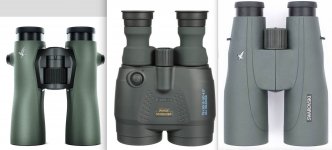
The Canon IS 18x50 is BIG! See a quick comparison to a medium sized conventional x42, the Swarovski NL; and the much larger SLC x56:
• Canon 18x50 - 7.6” (193 mm) OL (as is the 15x50 in the image)
• Swarovski NL x42 - 6.2” (158 mm) OL (with eyecups retracted)
• Swarovski SLC x56 - 7.6” OL (with eyecups retracted)
And see various size x42’s from Tobias at: greatestbinoculars: the magnificent five - 8x42 premium binoculars review Leica Ultravid Swarovski SLC and Swarovision Zeiss HT and SF
The NL is nominally 0.1” (2 mm) shorter than the EL SV in the image.
The Canon’s IS models are roughly a size larger than regular binoculars. Roger Vine has reviewed several at: Binocular Reviews
And there are some interesting comparison images:
a) Canon 15x50 and 12x36 III
b) Canon 14x32 and 12x36 III (without eyecups)
c) Meopta B1 12x50 and Canon 12x36 III
As can be seen: the Canon 12x36 (23.2 oz/ 660 g) approximates the size of a regular 12x50, and;
the newer Canon x32 line is somewhat bulkier (and heavier at 27.5 oz/ 775 g) than the 12x36.
. . . so as usual choices and compromises.
John

Attachments
Last edited:
MiddleRiver
Well-known member

Thanks! And yes... compromises.Hi MiddleRiver (post #89),
The Canon IS 18x50 is BIG! See a quick comparison to a medium sized conventional x42, the Swarovski NL; and the much larger SLC x56:
• Canon 18x50 - 7.6” (193 mm) OL (as is the 15x50 in the image)
• Swarovski NL x42 - 6.2” (158 mm) OL (with eyecups retracted)
• Swarovski SLC x56 - 7.6” OL (with eyecups retracted)
And see various size x42’s from Tobias at: greatestbinoculars: the magnificent five - 8x42 premium binoculars review Leica Ultravid Swarovski SLC and Swarovision Zeiss HT and SF
The NL is nominally 0.1” (2 mm) shorter than the EL SV in the image.
The Canon’s IS models are roughly a size larger than regular binoculars. Roger Vine has reviewed several at: Binocular Reviews
And there are some interesting comparison images:
a) Canon 15x50 and 12x36 III
b) Canon 14x32 and 12x36 III (without eyecups)
c) Meopta B1 12x50 and Canon 12x36 III
As can be seen: the Canon 12x36 (23.2 oz/ 660 g) approximates the size of a regular 12x50, and;
the newer Canon x32 line is somewhat bulkier (and heavier at 27.5 oz/ 775 g) than the 12x36.
. . . so as usual choices and compromises.
John
I had not and would never have thought I would, consider IS. But recent experience with mirrorless cameras and lenses, convinces me that IS is headed our way. But I'll probably wait till Leica does their version
John A Roberts
Well-known member

And two more images, this time comparing the Canon IS 10x30, 12x32 and 10x42.
From: Comparison: Canon 12x32 vs 10x30 IS II - Binoculars - Cloudy Nights
and: Canon 10x42L IS vs. Canon 12x32 IS... - Binoculars - Cloudy Nights
John
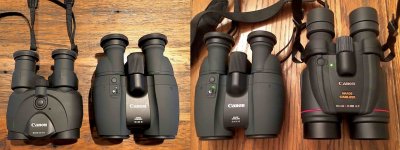
From: Comparison: Canon 12x32 vs 10x30 IS II - Binoculars - Cloudy Nights
and: Canon 10x42L IS vs. Canon 12x32 IS... - Binoculars - Cloudy Nights
John

John A Roberts
Well-known member

And so the IS debate rages on ..........Thanks! And yes... compromises.
Paul's review is a good balanced assessment. To add .... each individual (Canon) IS bin has strengths & weaknesses, just like all individual products e.g. 12x36 III is light, but not water resistant, has some CA, not really close focus, but still shows more than any non stabilised x12 bin.
If one wishes to use 'normal' (non-IS) bins handheld, then they can only provide a compromised/degraded view to the observer, as the 'shake' is unremovable without a tripod.
In some cases, such as hiking long distances over rough terrain or in very wet conditions, then I too use argon purged roofs (not Alpha, but good enough).
To exceed IS bins, one has to mount an Alpha on a tripod and not touch the ocular. IMHO this is a big compromise and I would gravitate to a spotting scope instead in most situations. An Alpha with a tripod is larger, heavier and far more cumbersome than an IS bin, even the 18x50 beast ( = comparable to a 18x50 porro).
So, the compromises one chooses are really dependant on exactly what the situation is at the time of use and which tools are available in the toolbox to use.
There are new products coming onto the market ....Fujinon TSX is one which could be a step forward in some ways.
If the big 3 produce an IS bin (ignoring the 20x60S) , then maybe they will be smaller, lighter, better optics, better battery life, etc. Until then ..........
Last edited:
Paultricounty
Well-known member

As usual great material. Thx JohnHi MiddleRiver (post #89),
The Canon IS 18x50 is BIG! See a quick comparison to a medium sized conventional x42, the Swarovski NL; and the much larger SLC x56:
• Canon 18x50 - 7.6” (193 mm) OL (as is the 15x50 in the image)
• Swarovski NL x42 - 6.2” (158 mm) OL (with eyecups retracted)
• Swarovski SLC x56 - 7.6” OL (with eyecups retracted)
And see various size x42’s from Tobias at: greatestbinoculars: the magnificent five - 8x42 premium binoculars review Leica Ultravid Swarovski SLC and Swarovision Zeiss HT and SF
The NL is nominally 0.1” (2 mm) shorter than the EL SV in the image.
The Canon’s IS models are roughly a size larger than regular binoculars. Roger Vine has reviewed several at: Binocular Reviews
And there are some interesting comparison images:
a) Canon 15x50 and 12x36 III
b) Canon 14x32 and 12x36 III (without eyecups)
c) Meopta B1 12x50 and Canon 12x36 III
As can be seen: the Canon 12x36 (23.2 oz/ 660 g) approximates the size of a regular 12x50, and;
the newer Canon x32 line is somewhat bulkier (and heavier at 27.5 oz/ 775 g) than the 12x36.
. . . so as usual choices and compromises.
John
View attachment 1460581
Paul
An Alpha with a tripod is larger, heavier and far more cumbersome than an IS bin
I fully agree!
But a mounted traditional bino is also a step up in terms of image stability. None of my 10 IS binoculars (7 Canon, 1 Fujinon, 1 Kenko, 1 Vixen) matches the image stability of any of my non-IS binos mounted on tripod (not even the optically fabulous 10x42 L which, I said it before, is unfortunately a pain to use for somebody with smallish hands and an IPD of 61 mm). And I generally still prefer a mounted large bino over a spotting scope for most uses.
Canip
Users who are viewing this thread
Total: 2 (members: 0, guests: 2)








